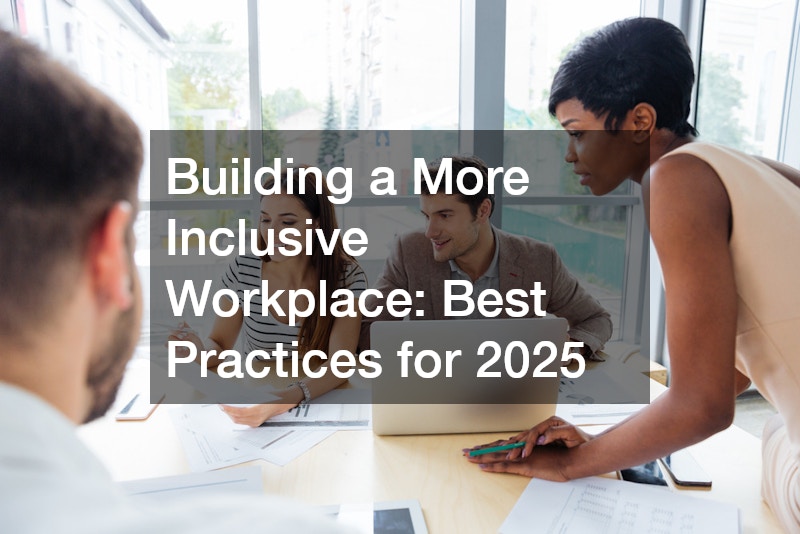In today’s fast-evolving business environment, cultivating an inclusive workplace is not just a moral imperative but also a strategic advantage. As organisations look to adapt to modern challenges, diversity and inclusion (D&I) initiatives have become central to creating a productive, innovative, and healthy work culture. In 2025, more organisations are recognising the undeniable benefits of inclusivity—such as improved employee engagement, increased innovation, and better talent retention.
However, building an inclusive workplace requires more than just lip service. It demands a dedicated, long-term effort. In this guide, we’ll explore practical steps and strategies for fostering inclusivity within your workforce in the years ahead. While these best practices apply to global contexts, they are tailored specifically to the dynamic business landscape.
The Importance of Workplace Inclusion in 2025
Before diving into the specifics of how to foster inclusion, it’s essential to understand why it matters. Inclusion in the workplace goes beyond simply hiring diverse talent—it’s about creating an environment where all individuals feel valued, respected, and empowered to contribute.
For businesses, an inclusive culture leads to:
- Better decision-making: Diverse teams are proven to make better decisions by considering multiple perspectives, ultimately leading to better business outcomes.
- Increased employee satisfaction and retention: When employees feel valued and understood, they are more likely to stay with an organisation long term.
- Enhanced innovation: Inclusive teams are more creative and bring forward fresh, diverse ideas that can drive product development and problem-solving.
1. Developing a Clear D&I Vision and Strategy
Effective inclusion starts with a clear vision. Your organisation needs to define what inclusion looks like and create a roadmap for how to achieve it. Without a well-articulated strategy, efforts to build an inclusive workplace will lack focus and direction.
Key Steps:
- Set clear, measurable goals: For example, aim to have a certain percentage of women in leadership roles or implement regular diversity training.
- Integrate D&I into the business plan: Inclusion should be woven into the fabric of your organisation’s values and operational goals.
- Involve leadership: Senior leaders must be role models for inclusion and champion the cause. Without their support, D&I initiatives are unlikely to gain traction.
2. Educate Your Workforce on Unconscious Bias

Unconscious bias refers to the stereotypes and assumptions that influence our decisions, often without us even realising it. These biases can affect hiring, promotions, and day-to-day interactions in the workplace. One of the most effective ways to address this issue is by offering training to help employees recognise and overcome their biases.
How to implement:
- Workshops and training: Regular unconscious bias training can help employees become more aware of their assumptions and behaviours.
- Inclusive hiring practices: Equip hiring managers with the tools to identify and combat biases during recruitment processes, ensuring a diverse talent pool.
- Encourage open conversations: Creating a culture where employees can talk about biases openly and respectfully will make a huge difference in addressing them.
3. Foster an Inclusive Hiring Process
Hiring is one of the most critical points of entry into an organisation, and it’s essential that the process is as inclusive as possible. A diverse team begins with a diverse recruitment pool, and that requires intentionality in how candidates are selected.
Steps for Inclusive Hiring:
- Expand recruitment channels: Don’t rely solely on traditional networks. Use a variety of job boards, social media platforms, and professional groups to reach underrepresented candidates.
- Standardise interviews: Ensure that interview questions are consistent across all candidates to avoid bias and give everyone a fair shot.
- Remove identifying information: Implement blind recruitment practices by removing names, genders, and photos from resumes to focus purely on skills and experience.
4. Build an Accessible Environment
Inclusivity goes beyond hiring—it’s about creating an environment where everyone feels they belong. An accessible workplace is one where people of all abilities, backgrounds, and identities can thrive.
Practical Considerations:
- Physical accessibility: Ensure that your workplace is physically accessible to all employees, including those with mobility issues. Consider ramps, elevators, and wider doorways.
- Digital accessibility: With the rise of remote work and digital tools, it’s critical to ensure that all online platforms are accessible to employees with disabilities, including screen readers and captioning.
- Flexible work arrangements: Not all employees work best in a 9-to-5 structure. Offering flexible work hours, remote work options, and part-time roles can help employees balance personal and professional commitments.
5. Establish Clear Policies on Harassment and Discrimination
A crucial aspect of an inclusive workplace is creating a safe space where discrimination and harassment are not tolerated. Employees need to feel confident that they will be protected from discrimination, regardless of their gender, age, ethnicity, or any other characteristic.
Key Elements:
- Clear policies: Develop a zero-tolerance policy for harassment and ensure that all employees are aware of these policies.
- Report systems: Offer confidential and accessible reporting systems for employees to report any concerns.
- Support for affected employees: Provide appropriate support for those who experience harassment or discrimination, whether through counselling, time off, or legal assistance.
6. Cultivate an Open Dialogue on Mental Health
Mental health is a key component of inclusion in the workplace. Employees need to feel comfortable discussing their mental health needs and accessing support if needed.
How to Foster Mental Health Support:
- Provide resources: Offer Employee Assistance Programs (EAPs) and mental health resources to employees.
- Encourage open conversation: Create an environment where employees feel comfortable talking about mental health without fear of judgement or reprisal.
- Mental health days: Allow employees to take time off when needed to manage their mental well-being, without fearing stigma or retribution.
7. Implement Employee Resource Groups (ERGs)
ERGs are groups within the organisation that are formed based on shared characteristics, such as gender, ethnicity, or sexual orientation. These groups are a powerful tool for fostering inclusion as they provide a safe space for employees to connect, share experiences, and advocate for change.
How to Encourage ERGs:
- Support from leadership: Leaders should actively support the formation and activities of ERGs and ensure they have the resources they need.
- Make it voluntary: Participation should be voluntary to encourage genuine involvement.
- Provide opportunities for growth: ERGs can be a source of mentorship and leadership opportunities within the organisation.
8. Promote Equal Pay and Opportunities for All Employees
One of the key areas where inequality remains prevalent is in compensation. Achieving pay equity is a vital part of the inclusivity puzzle. Employees should feel confident that their efforts and contributions are recognised fairly, regardless of gender, race, or other personal characteristics.
How to Ensure Equal Pay:
- Conduct regular pay audits: Regular audits will help you identify any discrepancies in pay and allow you to take corrective action.
- Transparent pay structures: Where possible, provide transparency around salary bands and progression opportunities, ensuring all employees are on an equal playing field.
- Offer mentorship opportunities: Ensure that all employees, regardless of background, have access to mentorship and career development opportunities to help them reach leadership positions.
9. Celebrate Diversity Through Employee Recognition Programs
Recognising and celebrating diversity in the workplace is another important element of inclusivity. Employee recognition programs can play a big role in making employees feel valued and acknowledged for their contributions.
How to Celebrate Diversity:
- Highlight diverse achievements: Recognise employees from different backgrounds for their hard work and achievements.
- Diversity-themed events: Host events that celebrate various cultural holidays, awareness days, and other diversity-related celebrations.
- Inclusive rewards programs: Make sure your rewards programs recognise a range of contributions, not just sales or productivity metrics.
Conclusion: A Journey Toward True Inclusion
Building a truly inclusive workplace is a long-term commitment, not a one-time initiative. It requires ongoing effort, commitment from leadership, and the active involvement of all employees. By implementing these best practices, organisations can create a culture where everyone feels valued and empowered to contribute their best work.
As we move toward 2025 and beyond, inclusive workplaces will become the standard, not the exception. Organisations that embrace inclusivity will not only enjoy stronger business outcomes but will also attract and retain the best talent, foster innovation, and contribute to a more equitable society.
